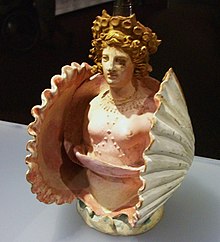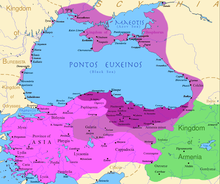User:Eumulos/Bosporan Kingdom
| This is the sandbox page where you will draft your initial Wikipedia contribution.
If you're starting a new article, you can develop it here until it's ready to go live. If you're working on improvements to an existing article, copy only one section at a time of the article to this sandbox to work on, and be sure to use an edit summary linking to the article you copied from. Do not copy over the entire article. You can find additional instructions here. Remember to save your work regularly using the "Publish page" button. (It just means 'save'; it will still be in the sandbox.) You can add bold formatting to your additions to differentiate them from existing content. |
Article Draft
[edit]Lead
[edit]The Bosporan Kingdom, also known as the Kingdom of the Cimmerian Bosporus (Greek: Βασίλειον τοῦ Κιμμερικοῦ Βοσπόρου, Basileion tou Kimmerikou Bosporou), was an ancient Greco-Scythian state located in eastern Crimea and the Taman Peninsula on the shores of the Cimmerian Bosporus, the present-day Strait of Kerch. It was the first truly 'Hellenistic' state in the sense that a mixed population adopted the Greek language and civilization, under aristocratic consolidated leadership[1]. Under the Spartocid Monarchs the aristocracy of the kingdom adopted a double nature of presenting as archons to greek subjects and kings to barbarians which some historians consider unique in ancient history[2]. The Bosporan Kingdom became the longest surviving Roman client kingdom. The 1st and 2nd centuries AD saw a period of a new golden age of the Bosporan state. It was briefly incorporated as part of the Roman province of Moesia Inferior from 63 to 68 AD, under Emperor Nero, before being restored as a Roman client kingdom. At the end of the 2nd century AD, King Sauromates II inflicted a critical defeat on the Scythians and included all the territories of the Crimea in the structure of his state.
The prosperity of the Bosporan Kingdom was based on the export of wheat, fish and slaves. Such, the Kingdom became the economic center of the Black Sea and is often dubbed the ancient Jewel of the Black Sea.[3] The profit of the trade supported a class whose conspicuous wealth is still visible from newly discovered archaeological finds, excavated, often illegally, from numerous burial barrows known as kurgans. The once-thriving cities of the Bosporus left extensive architectural and sculptural remains, while the kurgans continue to yield spectacular Greco-Sarmatian objects, the best examples of which are now preserved in the Hermitage in St. Petersburg. These include gold work, vases imported from Athens, coarse terracottas, textile fragments, and specimens of carpentry and marquetry.
Article body
[edit]Economy
[edit]Greek colonization in the Black sea region dates back into the dark ages, during which there is ample evidence of cultural and economic exchange between Greek and local populations as well as hostility. Scythian expansion and unification in the fifth century BCE leading to many of these settlements being wiped out or, turned into Scythian protectorates as was the case in the city of Olbia. It has been suggested that this pressure allowed the Archeanactid dynasty to create the first Bosporan state lasting from 480-438 BCE at which point it is overthrown by the Spartacid Dynasty beginning a period of economic expansion. The Black Sea Greeks before this period had dealt largely in goods like Animals, Slaves, Furs, and Fish with grain playing a minor role. Stemming from conditions caused by the Peloponnesian War the city of Athens had acquired a large demand for Grain, and the strain on their empire meant they could do little about Spartocids attacking the city of Nymphaeum which they relied on for black sea trade. Luckily for the Athenians the Spartocids were happy to trade all the grain they could grow for mainland goods and silver which presumably continued into Athenian decline[4].
Kings of Cimmerian Bosporus
[edit]
Archaeanactidae dynasty
[edit]According to Greek historian Diodorus Siculus (xii. 31) the region was governed between 480 and 438 BC by a line of kings called the Archaeanactidae, probably a ruling family, usurped by a tyrant called Spartocus (438–431 BC). Traditionally considered Thracian[5] due to the family name more recent historians have posited he was likely of Graeco-Scythian Descent typical of the region[2].
Spartocid dynasty
[edit]Spartocus founded a dynasty which seems to have endured until c. 110 BC, known as the Spartocids. The Spartocids left many inscriptions, indicating that the earliest members of the house ruled under the titles of archons of the Greek cities and kings of various minor native tribes, notably the Sindi (from central Crimea) and other branches of the Maeotae. Surviving material (texts, inscriptions and coins) do not supply enough information to reconstruct a complete chronology of kings of the region.[5]

Satyrus (431–387 BC), successor to Spartocus, established his rule over the whole region, adding Nymphaeum to his kingdom and besieging Theodosia, which was wealthy because, unlike other cities in the region, it had a port which was free of ice throughout the year, allowing it to trade grain with the rest of the Greek world, even in winter. Satyrus' son Leucon (387–347 BC) eventually took the city. He was succeeded jointly by his two sons, Spartocus II, and Paerisades; Spartocus died in 342 BC, allowing Paerisades to reign alone until 310 BC.[5] After Paerisades' death, a war of succession between his sons Satyrus and Eumelus was fought. Satyrus defeated his younger brother Eumelus at the Battle of the River Thatis in 310 BC but was then killed in battle, giving Eumelus the throne.[6]
Eumelus' successor was Spartocus III (303–283 BC) and after him Paerisades II. Succeeding princes repeated the family names, so it is impossible to assign them a definite order. The last of them, however, Paerisades V, unable to make headway against increasingly violent attacks from nomadic tribes in the area, called in the help of Diophantus, general of King Mithridates VI of Pontus, leaving him his kingdom. Paerisades was killed by a Scythian named Saumacus who led a rebellion against him.[5]
The house of Spartocus was well known as a line of enlightened and wise princes; although Greek opinion could not deny that they were, strictly speaking, tyrants, they are always described as dynasts. They maintained close relations with Athens, their best customer for the Bosporan grain exports: Leucon I of Bosporus created privileges for Athenian ships at Bosporan ports. The Attic orators make numerous references to this. In return the Athenians granted Leucon Athenian citizenship and made decrees in honour of him and his sons.[5]
Mithridates VI
[edit]
Pontic control was initially amicable over the Bosporans, but after his first defeat by Rome imposed Garrisons, and taxes on the population. The admiral of the Pontic navy Neoptolemus also engaged in at least two battles at land and sea against Scythian kingdoms in the eastern region of the kingdom[7]. After his defeat by Roman General Pompey in 66 BC, King Mithridates VI of Pontus fled with a small army from Colchis (modern Georgia) over the Caucasus Mountains to Crimea and made plans to raise yet another army to take on the Romans. His eldest living son, Machares, regent of Cimmerian Bosporus, was unwilling to aid his father, so Mithridates had Machares killed, acquiring the throne for himself. Mithridates then ordered the conscriptions and preparations for war. In 63 BC, Pharnaces, the youngest son of Mithridates, led a rebellion against his father, joined by Roman exiles in the core of Mithridates's Pontic army. Mithridates VI withdrew to the citadel in Panticapaeum, where he committed suicide. Pompey buried Mithridates VI in a rock-cut tomb in either Sinope or Amasia,[8] the capital of the Kingdom of Pontus.
References
[edit]- ^ Kozlovskaya, Valeriya (2017). The Northern Black Sea in Antiquity. Cambridge University Press. p. 173.
- ^ a b Moreno, Alfonso (2007). Feeding the Democracy: The Athenian Grain Supply in the Fifth and Fourth Centuries BC. Oxford University Press. p. 168.
- ^ "How the Bosporan Kingdom Became the Jewel of the Black Sea". 26 December 2018.
- ^ Moreno, Alfonso (2007). Feeding the Democracy. Oxford. pp. 171–172.
- ^ a b c d e Minns, Ellis (1911). . In Chisholm, Hugh (ed.). Encyclopædia Britannica. Vol. 4 (11th ed.). Cambridge University Press. pp. 286–287.
- ^ Head, Duncan. Armies of the Macedonian and Punic Wars. p. 70.
- ^ Tsetskhladze, Gocha (2015). The Bosporus after the Spartocid Kings. University of Naples. pp. 1–2.
- ^ Hojte, Jakob Munk. "The Death and Burial of Mithridates VI". Archived from the original on 2016-03-03. Retrieved 3 February 2015.
